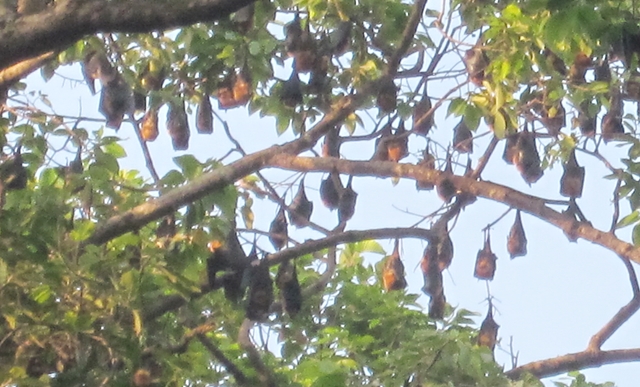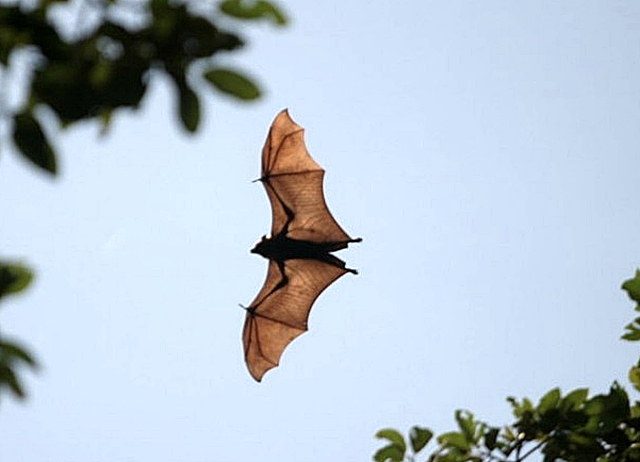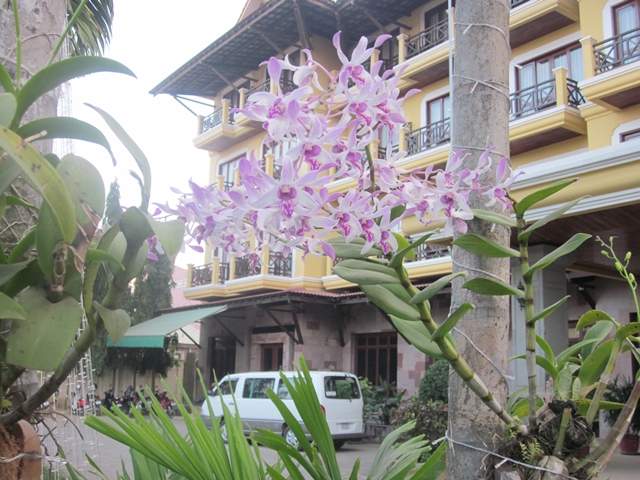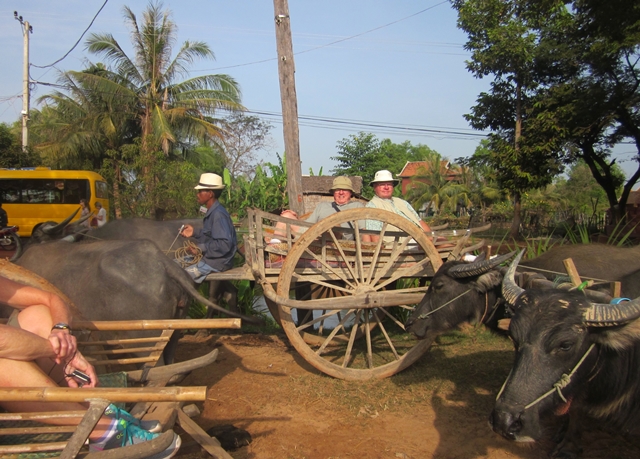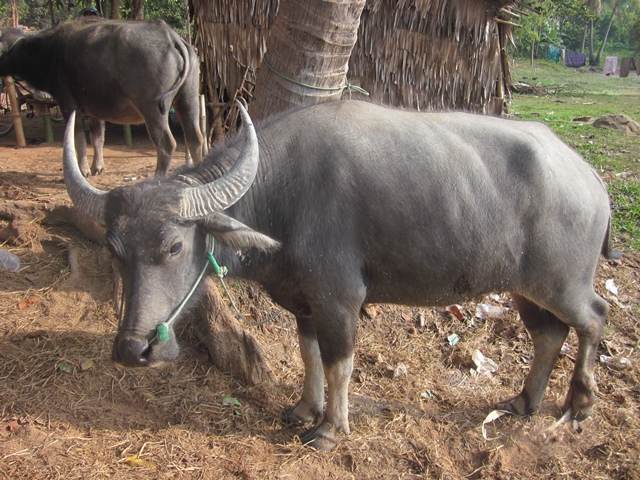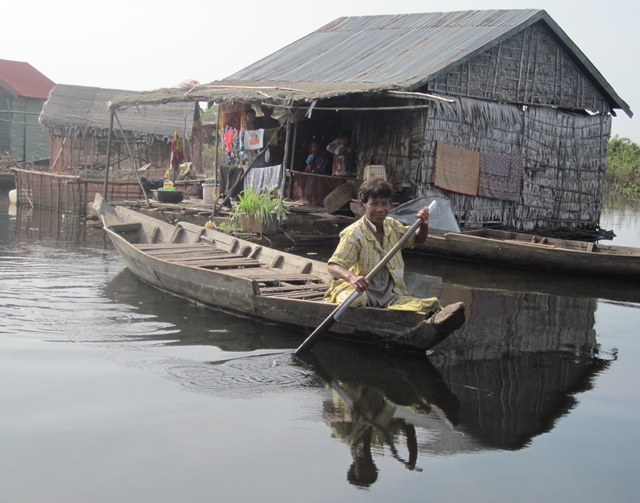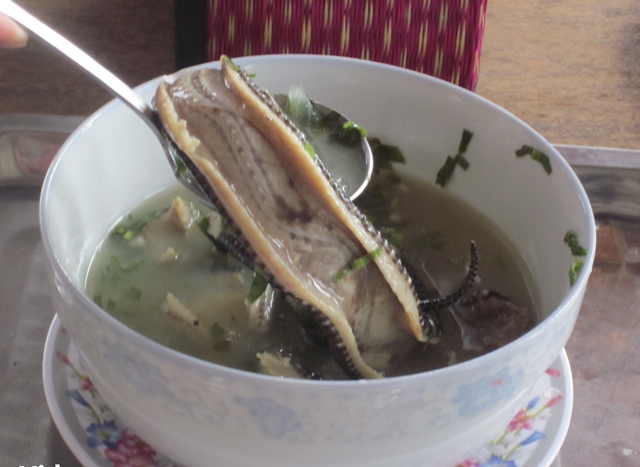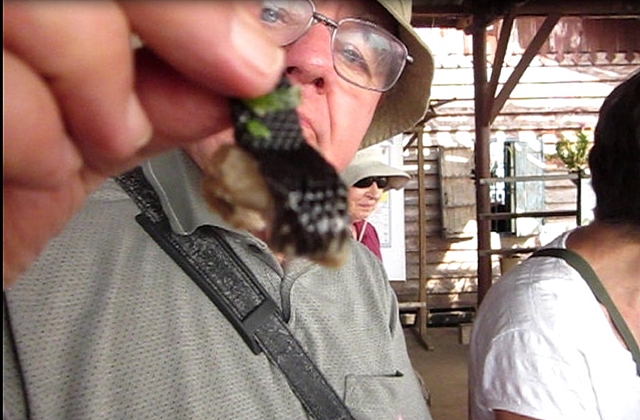Southeast Asia with Peter – Day 14 (Continued)
We had a short orientation walkthrough the Royal Independence Gardens in the center of town. Rath pointed out the Fruit Bats in the trees. They were huge! These bats are locally known as the Flying Foxes because the reference to a flying mouse would be highly disproportionate to their actual size. Their wingspan can reach up to 5 feet!
The bats also inadvertently help thousands of durian farmers whose fruits would not be as delicious were the bats not present to pollinate their trees. They are also part of the local food chain.
We arrived at the Paradise Hotel, checked in and I went for a haircut. It cost $2.00 and I gave a $1.00 tip. Big spender, ey?
 Back to the room for a shower and an early “to bed” to end Day 14.
Back to the room for a shower and an early “to bed” to end Day 14.
Southeast Asia with Peter – Day 15
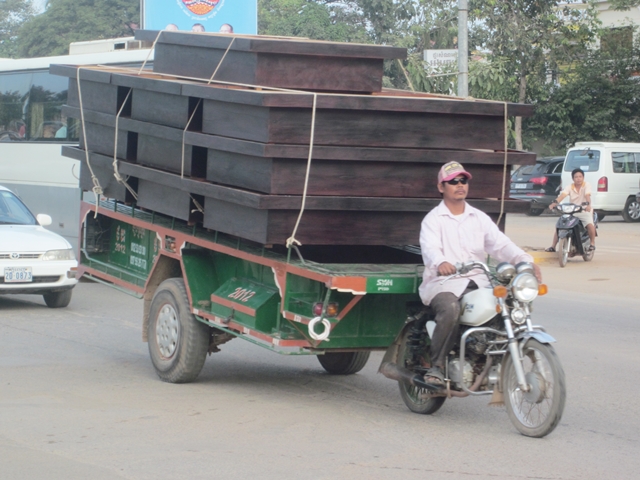
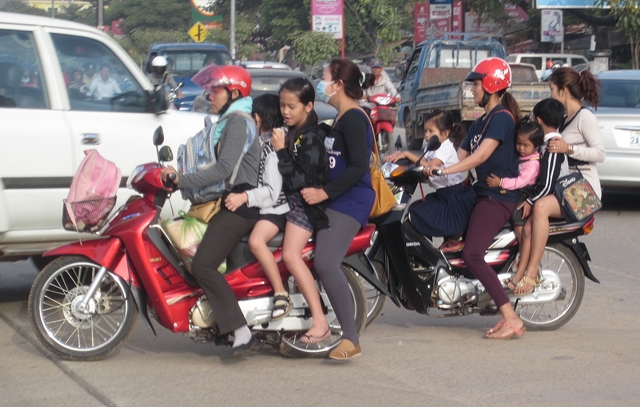 The day started with a ride through Siem Reap’s streets heading to the Ton Le Sap. I’m always fascinated by the way people use motor bikes. I don’t know what the guy in the top pic was carrying, but it was a big load of somethisg. The bottom pic shows 2 bikes with a total of 9 passengers (Count ’em.). The drivers are required to wear helmets But not passengers?
The day started with a ride through Siem Reap’s streets heading to the Ton Le Sap. I’m always fascinated by the way people use motor bikes. I don’t know what the guy in the top pic was carrying, but it was a big load of somethisg. The bottom pic shows 2 bikes with a total of 9 passengers (Count ’em.). The drivers are required to wear helmets But not passengers?
We stopped at a place where you could have a brahma bull or water buffalo cart ride. We chose a snappy dual water buffalo cart and were treated to a bumpy ride on a muddy cart track littered with poops. Some fun!! Note the power steering rope through the nose. Access to the Ton Le Sap lake was via this canal. Note the ever present Spirit House.
Access to the Ton Le Sap lake was via this canal. Note the ever present Spirit House.
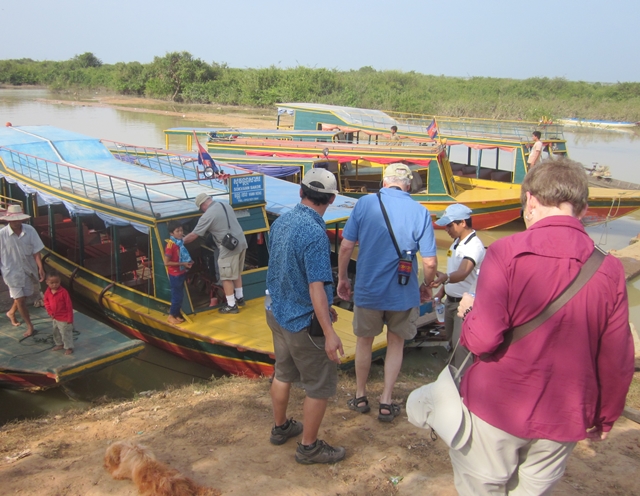 Before boarding we were photographed by a Canbodian TSA Agent.
Before boarding we were photographed by a Canbodian TSA Agent.
 Pete and Fred enjoyed a good laugh. The rest of the crew enjoyed the views. .
Pete and Fred enjoyed a good laugh. The rest of the crew enjoyed the views. .  Trees along the canal were interesting: They are totally submerged during high water. As the water receded, leaves will appear on the tops of the exposed branches. By the time the water was fully gone, the tree will be fully leafed out. Ain’t Mother Nature grand?
Trees along the canal were interesting: They are totally submerged during high water. As the water receded, leaves will appear on the tops of the exposed branches. By the time the water was fully gone, the tree will be fully leafed out. Ain’t Mother Nature grand?
When we finally reached the actual Ton Le Sap lake, we came to a floating village (above). This is the Mechrey Community. It is a community based tourism project with a “typical” floating village and some flooded forest.
The Tonlé Sap aka: “Large Fresh Water River”, but more commonly translated as “Great Lake”) is a combined lake and river system of major importance to Cambodia. It is the largest fresh water lake in South East Asia and is an ecological hot spot that was designated as a UNESCO biosphere in 1997.
The Tonlé Sap is unusual for two reasons: its flow changes direction twice a year, and the portion that forms the lake expands and shrinks dramatically with the seasons. From November to May, Cambodia’s dry season, the Tonlé Sap drains into the Mekong River at Phnom Penh. However, when the year’s heavy rains begin in June, the Tonlé Sap backs up to form an enormous lake.
Through the phenomenon of decomposition, the flora is the source of the Tonle Sap’s great fish productivity, making it one of the world’s most productive bodies of inland water. It also creates nesting niches for fish, provides an important habitat for many wildlife species, as well as a means of livelihood and subsistence for many people living near or on the Tonle Sap Lake.
We visited a “floating store” that had a lot of tourist stuff for sale I bought Mary Ann a piece of printed fabric for her “stash”. She wasn’t too impressed.
They also had captured crocodiles there. They would be sold for meat and hides. But the “piece de resistance” was this water snake soup. Of course, Peter was first in line to try it. He said it tasted like chicken, so I tried is. It was not too bad (compared to tarantulas).
As we started to head back, our boat’s motor quit. We had to be towed in.
 Back in Siem Reap we had a nice lunch complete with delicious mango, dragon fruit, watermelon and a flan. It sure beats snakes and spiders!
Back in Siem Reap we had a nice lunch complete with delicious mango, dragon fruit, watermelon and a flan. It sure beats snakes and spiders!
 We reboarded the bus and headed to the Banteay Srei. On the way we stopped at a noodle “factory” Our host kneaded a fresh batch of rice dough, pressed it through an extruder, cooked it into a soup and gave us samples.
We reboarded the bus and headed to the Banteay Srei. On the way we stopped at a noodle “factory” Our host kneaded a fresh batch of rice dough, pressed it through an extruder, cooked it into a soup and gave us samples.
 I thought it was quite good, but I noted there was “happy room” over my shoulder – just in case.
I thought it was quite good, but I noted there was “happy room” over my shoulder – just in case.
On we o to our first Angkor Wat temple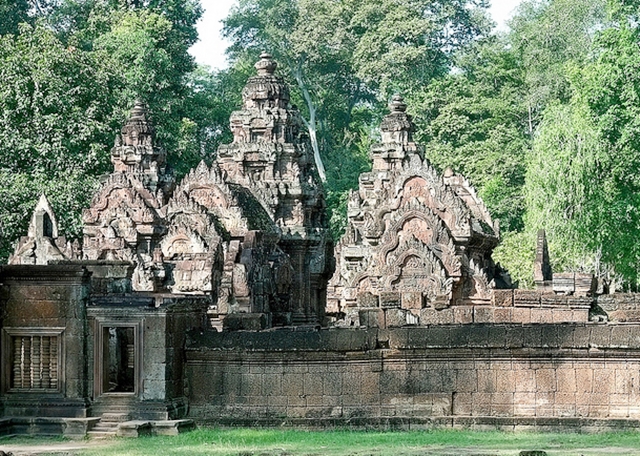
This is the Banteay Srei temple It is a 10th century temple dedicated to the Hindu god Shiva. Located in the area of Angkor. It is built largely of red sandstone, a medium that lends itself to the elaborate decorative wall carvings which are still observable today. The buildings themselves are miniature in scale, unusually so when measured by the standards of Angkorian construction. These factors have made the temple extremely popular with tourists, and have led to its being widely praised as a “precious gem”, or the “jewel of Khmer art.” We knocked on the door and went in.
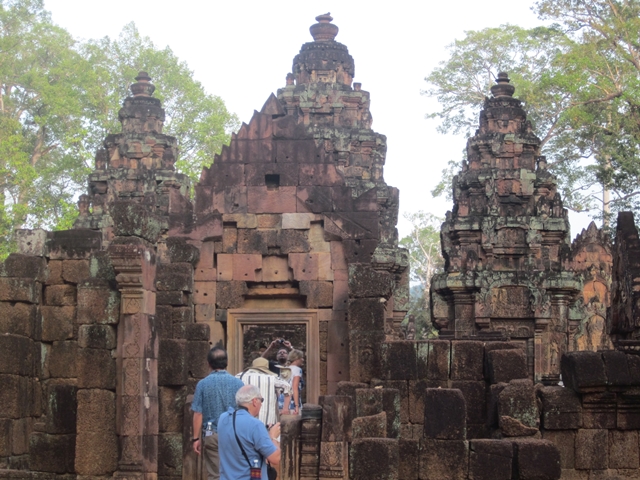
 There were smaller temples inside. Note the temple monkey statue.
There were smaller temples inside. Note the temple monkey statue.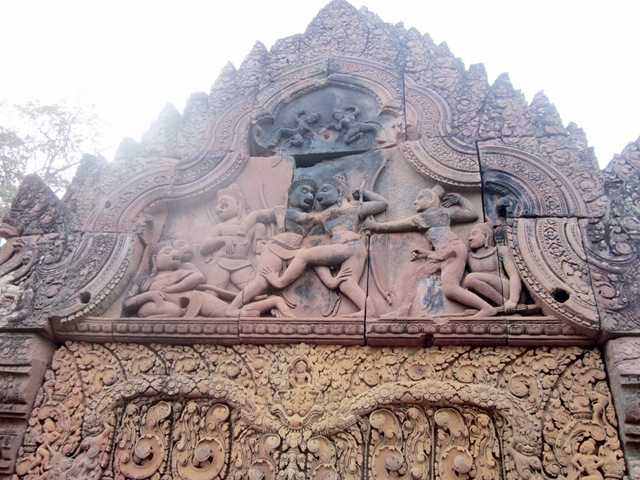
 The most impressive artwork were the carving on the pediments above the doors. Many were missing, probably stolen by tomb raiders. Each carving tells a story, if you had time and resources to figure them out.
The most impressive artwork were the carving on the pediments above the doors. Many were missing, probably stolen by tomb raiders. Each carving tells a story, if you had time and resources to figure them out.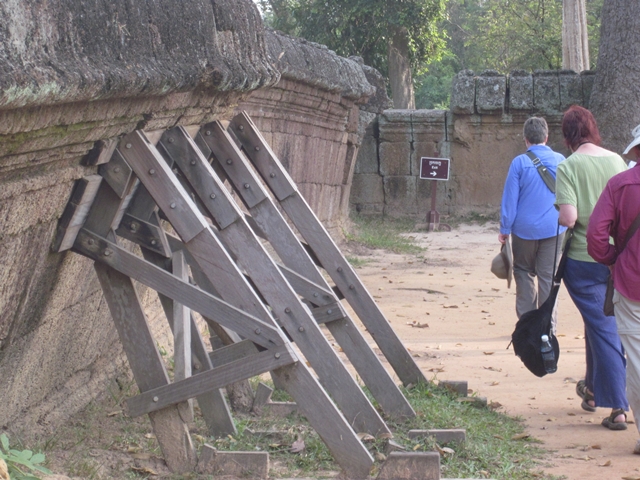 Time has taken its toll on some of the structures, but we could wander at will.
Time has taken its toll on some of the structures, but we could wander at will.
It was time to head back to town. Tomorrow we will visit the temples at Angkor Wat. On the way to town we stopped a palm sugar “store” and heard how they made palm sugar:


